These days, electric guitars come in a huge and ever-evolving range of shapes and sizes. Some of them are sleek and elegant, and some are more striking, sharp, and sporadic.
But what does it all mean? Does the body shape of an electric guitar have a crucial impact on the sound? How comfortable they are to play? Or is it purely aesthetic?
Well, the answer is a little bit of all these things – but the balance between the three can vary depending on the guitar.
Before we dive into guitar body shapes, though, it’s important to establish the different body types of electric guitars – and where they came from. You can find more about this and which electric is best for beginners here.
Electric guitar body types
For the most part, there are three main body types of electric guitar:
- Hollow body
- Solid body
- Semi-hollow body
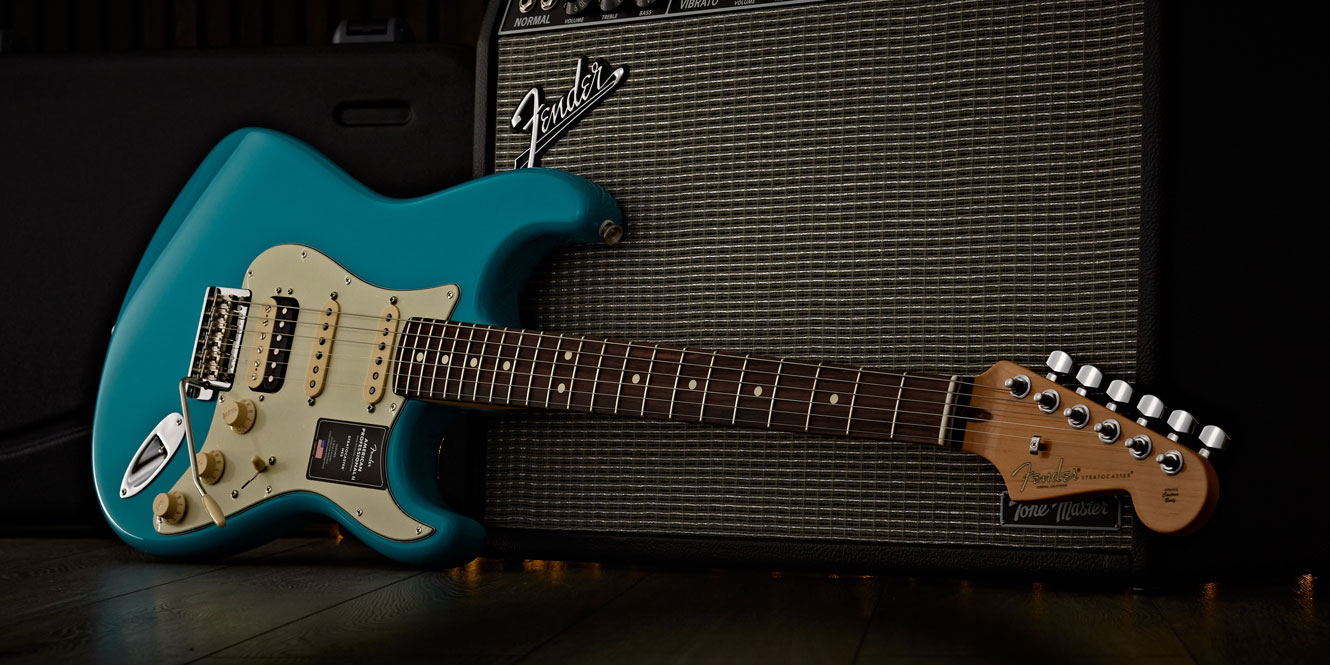
There are denominations within each of these, as well as designs that sit somewhere in the middle, such as chambered body guitars, but we’ll get to all of that later.
Now, it’s all good and well knowing what these three different types of guitars are, but what do they mean?
Solid body
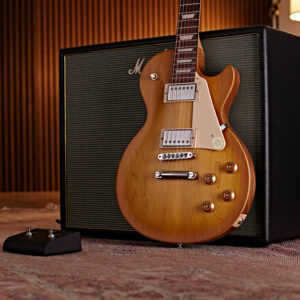 Solid body guitars are probably the first type of guitar that springs to mind when you think of electrics, and they’re the most common.
Solid body guitars are probably the first type of guitar that springs to mind when you think of electrics, and they’re the most common.
This body type means that the guitar comprises one or more solid wood, with no holes or hollowed-out gaps anywhere other than where the pickups and controls are placed.
Guitars with a solid body produce a very different sound to hollow-bodied instruments.
They also offer more tonal variation, depending on which guitar you use and – crucially – what pickups it’s equipped with.
Generally speaking, solid body instruments project the best amount of sustain, as well as the highest resistance to feedback thanks to the density of the wood.
These factors contribute to a much tighter low-end and they react well to being run through an overdriven channel – which is why they’re often affiliated with the heavier rock sounds they were originally designed for.
Hollow body
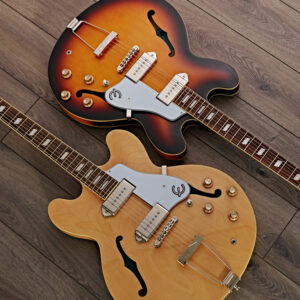 Hollow body guitars are (you guessed it) hollow inside. They’re also about as close as you can get to an acoustic experience with an electric guitar. This is because hollow bodies were some of the earliest types of electric guitars ever designed and were largely based on the acoustic shape.
Hollow body guitars are (you guessed it) hollow inside. They’re also about as close as you can get to an acoustic experience with an electric guitar. This is because hollow bodies were some of the earliest types of electric guitars ever designed and were largely based on the acoustic shape.
However, they were made with an electric pickup and two F-holes rather than the singular round hole in the middle.
Beloved by jazz musicians for their well-rounded, rich, and warm tones, hollow-bodied electrics deliver a loud sound that’s full of character, even when they’re not plugged in.
Their rounded tone produces a booming low end that can often lead to intense and overbearing feedback, which is why they’re more commonly used for cleaner guitar sounds in jazz and softer rock ‘n’ roll.
If you’re a Beatles fan you’ll know that John Lennon famously used an Epiphone Casino, a prime example of a delightful and tonally vibrant hollow body.
Semi-hollow body
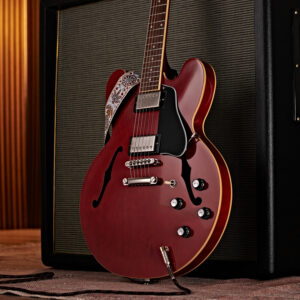 Semi-hollow body guitars were designed to get the best of both worlds – but their tone is probably best described as an attempt at a hollow body without the irritating drawbacks.
Semi-hollow body guitars were designed to get the best of both worlds – but their tone is probably best described as an attempt at a hollow body without the irritating drawbacks.
These types of guitars react much better to high-gain and overdriven channels than their hollow-bodied cousins. However, they still produce feedback if you push them to seriously high outputs of distortion.
Their delicious tones range from softer, rounded jazz harmonics to fuzzier and more aggressive humbucking sounds reminiscent of the early days of rock ‘n’ roll.
Perhaps the best example of a semi-hollow that achieves this balance is the Gibson ES-335 – enjoyed by the likes of rock ‘n’ roll legend B.B. King for precisely these reasons.
Semi-hollows are built in the same fashion as hollow-bodied guitars but feature a reinforced solid centre that goes from the neck to underneath the body top and houses the pickups.
Typically, semi-hollow guitar bodies have a rounded double-cutaway with two F-holes, giving that beautifully distinguished and classic aesthetic. Their typically large, round, and symmetrical body is reminiscent of the hollow-bodied and acoustic guitars that were the blueprint of the semi-hollow design.
Which one is for me?
It’s important to establish these three categories as they have a huge effect on the sound of a guitar.
The right one for you comes down to the genre of music you’ll use it for.
Semi hollows are quite versatile and can be used for styles like jazz, pop, blues, and alt-rock thanks to their resonance and acoustic-esque tone. Fully hollow guitars are more common in jazz.
But when it comes to solid bodies, the main impact on their sound comes from the pickups, meaning they can accommodate pretty much any genre of music with more focus and less feedback.
Electric guitar bodies – a walk through time…
In 1931, Electro-string (now Rickenbacker) released the first ever electric guitar with their ‘Frying Pan’ guitar design.
Very few were produced, and none were officially released on sale to the public – but the technology proved to be a revolutionary turning point in music history, paving the way for a tidal wave of electric guitar production over the last 90 years.
Gibson ES-150 & ES-175
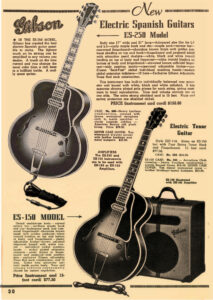
Creative Commons License by Gibson Guitar Corporation
Generally acknowledged as the first commercially successful electric guitar, Gibson released their Spanish-style ES-150 in 1936.
Named after the price of the guitar upon its initial release ($150), the ES stands for ‘Electric Spanish’ as the body design was inspired by that of a traditional Spanish acoustic.
A single pickup enabled its electric capabilities, and it immediately became popular with jazz guitarists at the time for its gentle and well-rounded tones.
The body shape followed the traditional design of an acoustic with a rounded top and larger, also rounded bottom – this guitar falls under the hollow body category.
Gibson’s ES-175 was released some years later in 1949.
This was another hollow-bodied archtop guitar similar to the 150 that featured a single P90 pickup (which later became two) but with a Florentine cutaway body, offering additional access to those higher strings.
The cutaway design of a hollow-bodied guitar may reduce the natural resonance and tone of a guitar ever so slightly, just like it can on an acoustic. But this was hardly noticeable on the ES-175 and the additional access to the higher strings provided the extra bit of creativity that inspired guitar makers to re-think body shapes/designs.
Fender Broadcaster (Telecaster)
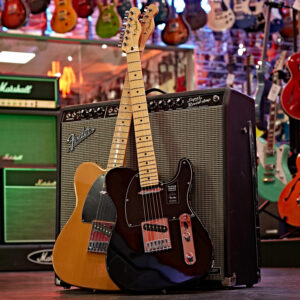 A year prior to the release of the 175 by Gibson, Fender burst onto the scene with their first offering – and it was a big one. The Fender Broadcaster – quickly renamed to Fender Telecaster – was the first solid body guitar ever made.
A year prior to the release of the 175 by Gibson, Fender burst onto the scene with their first offering – and it was a big one. The Fender Broadcaster – quickly renamed to Fender Telecaster – was the first solid body guitar ever made.
Designed to focus a little more on functionality and sound rather than aesthetics, the reason for using solid blocks of wood was to achieve the great sound of electric Hawaiian guitars while avoiding the roaring feedback issues. It worked, and the innovation didn’t stop there.
The two-pickup solid body was fitted with a bolt-on neck featuring a truss rod – a first for an electric guitar. Now, this is commonplace for all solid body builds.
The shape of the Telecaster body still resembles the traditional Spanish guitar shape with an additional cutaway. However, the thin solid body and slightly more squared-off sides give it a more modern, refined appearance.
The outcome of Fender’s innovation on this revolutionary guitar was a bright, resonant, and responsive sound that was extremely resistant to distorted feedback. It became an instant hit with blues and jazz musicians, and eventually became a staple of country and rock genres in years to come.
Gibson Les Paul
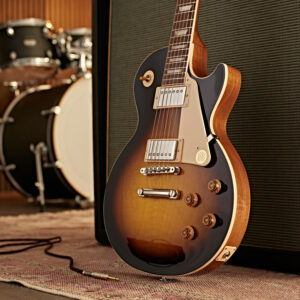 Gibson’s response to the Telecaster came fast and fierce in 1952 when they debuted their first solid body: the Les Paul.
Gibson’s response to the Telecaster came fast and fierce in 1952 when they debuted their first solid body: the Les Paul.
Perhaps the most successful Gibson ever made, the Les Paul was a result of a collaboration between Gibson and jazz guitarist Les Paul.
A must-have for reaching those higher strings, the single-cutaway featured again on this design and, following suit from Fender, the Les Paul also featured two pickups. The difference? This was the first guitar to be equipped with the revolutionary humbuckers, fitted in 1957.
The guitar was not released to instant acclaim. In fact, it was discontinued between 1961 and ’68.
Its humbucking pickups, however, gave the guitar its unique and powerful sound that has become a legendary staple of rock genres for generations.
The Gibson Les Paul was, and perhaps still is, unrivalled for its sustain and is one of the most famous electric guitars of all time.
Fender Stratocaster
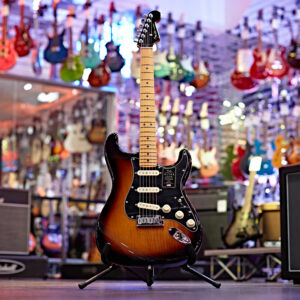 1954 saw the biggest development in electric guitar history. It was the year Fender released the most famous and instantly recognisable (sonically and visually) guitar of all time: the Stratocaster.
1954 saw the biggest development in electric guitar history. It was the year Fender released the most famous and instantly recognisable (sonically and visually) guitar of all time: the Stratocaster.
In years to come, the Fender Stratocaster would prove an incredibly influential guitar. It was the biggest leap forward in guitar engineering and was full to the brim with specs previously never seen on an electric guitar.
Designed by Fender as the next step after the Telecaster, the body shape featured a double cutaway, which was the first of its kind. This offered fantastic access to the higher registers of the neck and had very little impact on the sound of the guitar.
The Strat also falls under the solid body category.
Its rounded edges were a first, and crucially, its three single coil pickups with a 5-way selector meant that players had access to a far wider range of tones than ever before.
Another revolutionary design feature was the tremolo arm. Included on all standard models of the Stratocaster, the tremolo arm – or whammy bar – was attached to a floating bridge and offered a new style of playing.
Over time, this guitar has been enjoyed by legends such as Jimi Hendrix, David Gilmour, Eric Clapton, and countless others – and will remain a game-changing feat of guitar engineering until the end of time.
Gibson ES-335
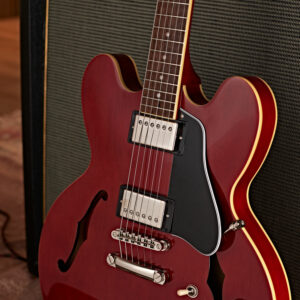 Four years after the release of the Strat, Gibson came back with their next offering.
Four years after the release of the Strat, Gibson came back with their next offering.
The Gibson ES-335, a semi-hollow-bodied guitar that was almost a mix of the earlier ES-175 and Les Paul, was met with immediate acclaim.
With its gentler, rounded, and more hollow-bodied tones combined with the bite and aggression of the double humbuckers, the 335 offered a highly diverse playing experience that ranged from jazz and old-school blues to progressive rock.
This guitar was also chosen to represent the fictitious birth of rock ‘n’ roll in its most famous cameo when it was, of course, played by Marty McFly in Back to the Future.
Alongside a highly versatile sound, this has to be one of the best-looking guitars out there.
The mixture of classic and modern styles incorporated in the design makes for a clean-cut, double-cutaway electro-acoustic appearance that is vintage to its very core.
Fender Jazzmaster
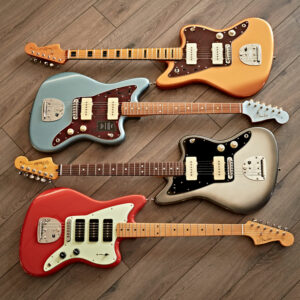 1958 was a big year for the electric guitar.
1958 was a big year for the electric guitar.
At the same time as the release of the ES-335, Fender released the Jazzmaster.
It was originally aimed at jazz guitarists but later became a staple of new-wave, alternative, surf, and punk genres.
By this point, Fender had realised that there’s a little more leeway with solid body guitar shapes.
So, the Jazzmaster featured a more askew design, with a very small, smooth cutaway on the underside and a larger, more angled cutaway on the top side – it’s an iconic, eye-catching design that’s instantly recognisable.
The Fender Jazzmaster was the first Fender guitar to have two individual tone circuits, and it came equipped with two single-coil pickups.
Gibson Flying V & Explorer
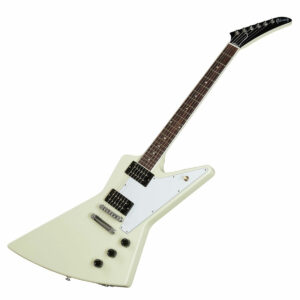 Gibson were having a great year in 1958, and on the back of the ES-335’s success, the Gibson Flying V and Gibson Explorer were released.
Gibson were having a great year in 1958, and on the back of the ES-335’s success, the Gibson Flying V and Gibson Explorer were released.
These two guitars came from the company that had first popularised the electric guitar with a body shape that strongly resembled a concert acoustic.
But 22 years later, Gibson spearheaded the breakaway from tradition with the Flying V and Explorer.
These models proved that you could push the boundaries of solid-bodied electric guitar shapes much further whilst retaining a consistent and unique guitar tone.
They were not, however, released to instant acclaim.
Most likely way ahead of their time, both were made in limited numbers and discontinued.
The Flying V was the first to return in 1967, followed by the Explorer in 1976.
Gibson SG
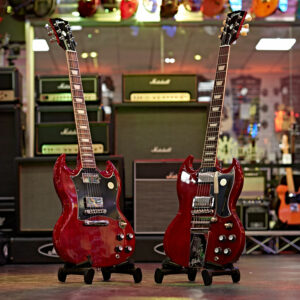 Quite possibly Gibson’s most famous and recognisable guitar, and highly similar to the Gibson Les Paul, 1961 saw the launch of the Gibson Les Paul SG.
Quite possibly Gibson’s most famous and recognisable guitar, and highly similar to the Gibson Les Paul, 1961 saw the launch of the Gibson Les Paul SG.
It was later renamed to just the Gibson SG because Les Paul didn’t like the design.
Another solid body, the SG bares a strong resemblance to the Les Paul.
However, there are some differences.
For example, a sharp double-cutaway gives the guitar that hard-hitting rock appearance, whilst a slimmer body and neck allow for faster manoeuvrability.
The neck also joins the body at the 22nd fret on the SG, as opposed to the 16th fret on the Les Paul.
This provides much easier access to the higher frets, and it makes a big difference when you’re shredding way up there in the gods, trying to channel your inner Angus Stone.
Fender Mustang
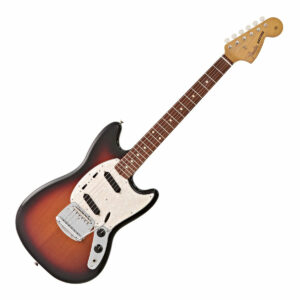 Through the 1950s, Fender had identified a gap in the market for student guitars, releasing a range of guitars that were scaled down in body size and had a slightly shorter scale length.
Through the 1950s, Fender had identified a gap in the market for student guitars, releasing a range of guitars that were scaled down in body size and had a slightly shorter scale length.
In 1964 they released what was to be the last and most successful addition to the student series – the Fender Mustang.
Another solid body guitar, the Mustang was intended for a younger, budding guitarist, providing a more comfortable playing experience.
And with slightly more delicate single coil pickups, it was also designed for more rhythmic and open styles of playing rather than lead.
The scaled-down body size offered a great advantage in the way of comfort with little (if any) sacrifice in the quality of sound.
The Mustang became a cult favourite for alternative, punk, and indie guitarists and is hugely popular to this day, perhaps most notably being played by Kurt Cobain throughout most of his Nirvana career.
Find out more
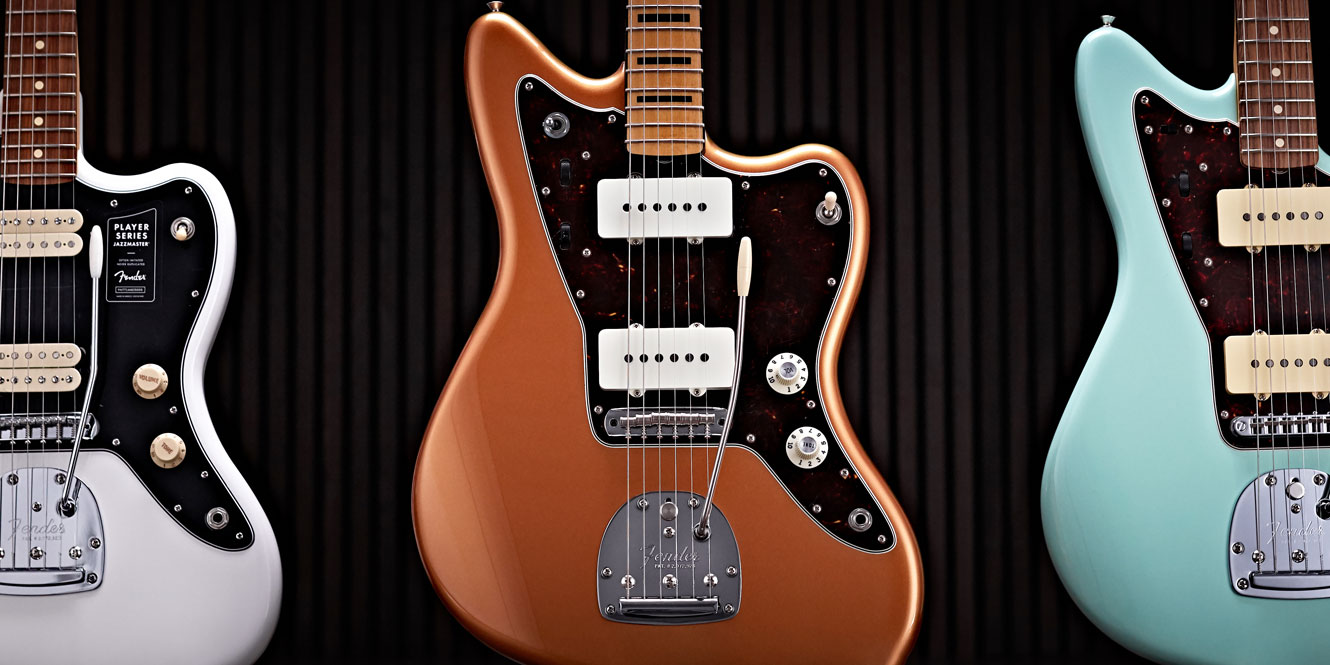
So, there you have it, a crash course in electric guitar body shapes! If you’re an indie-rocker, why not check out our article on the history of indie guitars? Or if you’re more of a bassist, our guide to electric bass bodies is for you!

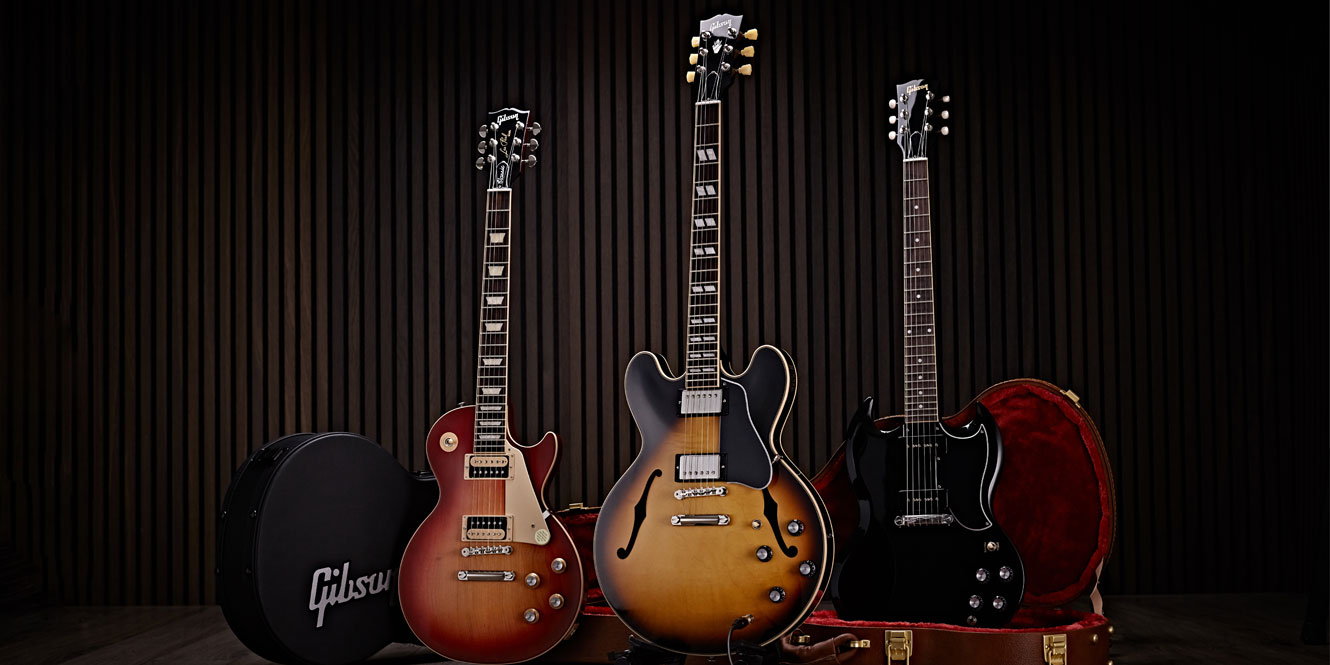











Jazzmaster pickups are not p90s, they are completely different.
Hi Mark,
Good spot! We have amended the slight error in the article.
Thanks,
Maisie